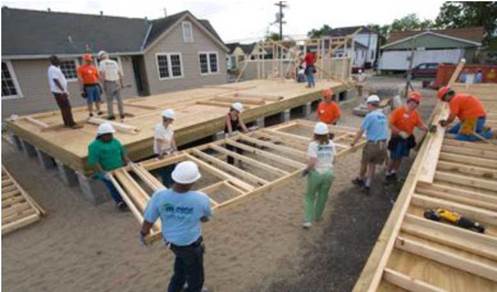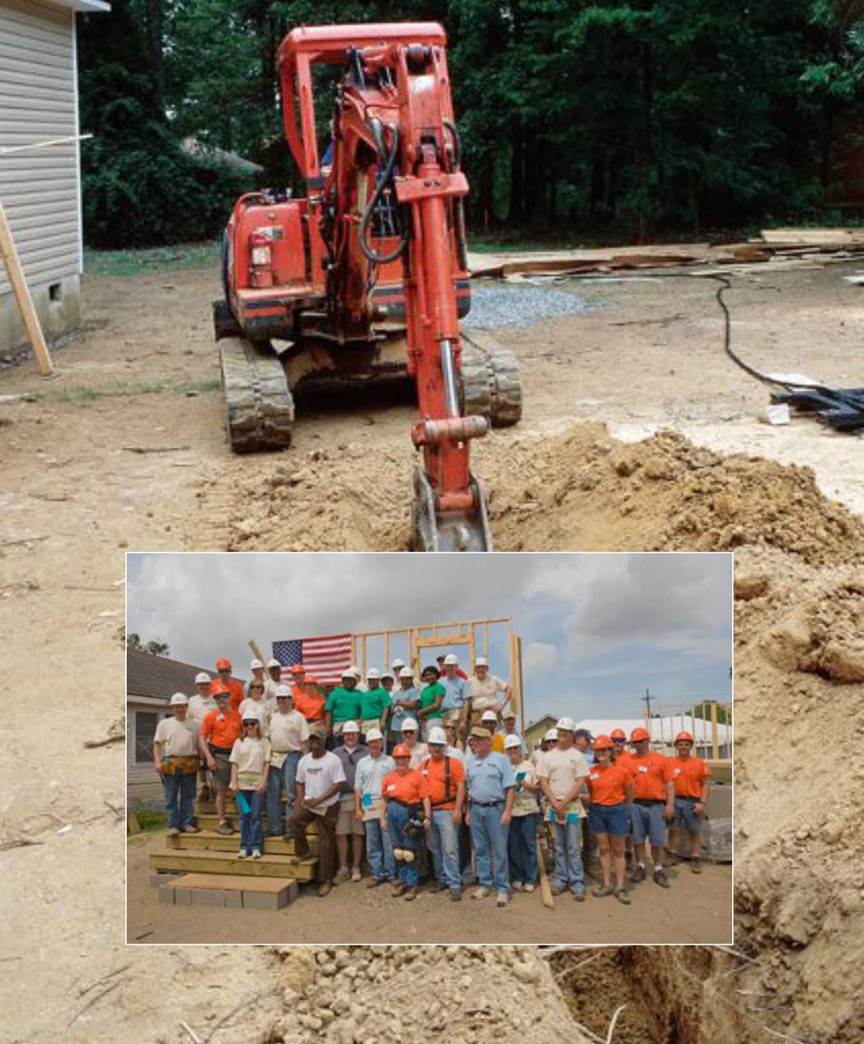A HOUSE
Since this book was first published in 2002, the need for decent, affordable housing in this country (and throughout the world) has only increased. It is astonishing, but millions of families spend over one-third of their income on housing alone. Even families with steady middle-class incomes struggle to purchase homes and make mortgage payments on time. Money that used to go toward medical care, food, and a child’s education is now spent so families can keep a roof over their heads.
I was born and raised in a wood-frame house sited high on the short-grass prairies of western Nebraska, that huge inland sea of grass where the only constant is the wind whistling across the snow-covered, sagebrush hills. Aged, warped, unpainted clapboard siding hardly slowed the wind and cold. It was an uninsulated farmhouse with no central heating, no electricity, no indoor plumbing, and windows that let in more wind than light. Just 3 ft. from the iron stove in the kitchen, it was freezing. In our bedrooms, even when Mother warmed the sheets with her flat iron, the temperature never got much above what it was outside. Wallpaper, as the saying goes, was used not for decoration, but for insulation.
After high school, I headed south. The first framing job I worked on was in Los Angeles in
1950. There were lots of carpenters, all wearing white overalls, cutting different pieces of wood with sharp handsaws and nailing them together with 16-oz. curved-claw hammers. The pace was slow and methodical. A wall chalkline would be snapped on the floor. The bottom plate was nailed to the line. Corner posts were then set and a string pulled taut over posts from corner to corner. The length of each wall stud was measured from that string. Once the studs were cut and toenailed to the bottom plate, we would stand on ladders and nail on the top plate. It took a month or so to frame a house.
Six months later, I was one of a small crew, all wearing jeans and nail aprons and wielding long-handled, 20-oz. framing hammers. GIs were returning from the war by the millions and the postwar housing boom was underway. We were framing tract houses, one every couple of days. Those were affordable housing units, decent homes in decent communities, two – and three-bedroom houses with about 1,000 sq. ft. of living space. They were definitely not mansions. In 1951, my brother Jim moved into one of those houses with his family. It cost him $400 down, with monthly payments of $63, which included taxes and insurance. Fifty years later, those houses are still standing, and they have seen
|

more than one generation of children grow up, move on, and start families of their own. We do know how to build affordable housing.
Habitat for Humanity (HFH) is one group that not only knows this to be true but also is doing something with that knowledge. All across this country, in hundreds of towns and cities, people like you and me are working with our neighbors to build decent, affordable housing. In the past 30 years, more than 225,000 affordable houses have been built in America and in other countries by HFH affiliates. Families that otherwise would not have even dared to dream of owning their own homes have been given a “hand up” to dwellings that they can actually afford. But make no mistake: This isn’t charity—the houses are not given away. Rather, in addition to shouldering a modest mortgage, the new homeowners put in around 500 hours of “sweat equity,” working with volunteers who help them build their house. In the few years I have lived here in Coos Bay, Oregon, we have built 17 houses that have become homes for the families who worked with us. Because of all the volunteer labor, we are able to build these houses for about $55,000, including land, which results in a mortgage that even low-income families can handle.
If HFH can build an affordable house, why can’t anyone? First of all, others are doing it. More than 175,000 owner-builders create new housing units each year. It takes a significant amount of courage, effort, and time, not to mention a piece of land, some money, and help from friends—but it can and is being done. How to build a simple house is not a mystery.
It’s rather like putting together Lego® blocks or Lincoln Logs’™, one piece at a time. Many of you already have the basic skills needed to build a simple house. Just look at the thousands of people who flood places like home improvement stores to buy tools and materials for working around their homes.
If you’re considering building your own home, keep in mind that it is also possible to
Photo courtesy HFH I
build a home that is beautiful but, in the long run, is neither decent nor affordable. Decent housing, for example, doesn’t have leaks that can cause mold and rot, compromising both your health and your home. Neither is decent housing full of toxic fumes, which can come from paint, carpet, and a host of other common, seemingly innocuous materials. A decent, affordable home is energy efficient, well ventilated, and comfortable; built from safe, health-preserving materials; and requires a minimum of upkeep or maintenance. It can also be built from forest products and other materials that are sustainable, so that we don’t further lay waste to our homeland. Building such a home isn’t impossible, but it does take some careful planning.
So, where do you start? There is an old saying, “You can hear a lot just by listening.” Talk to neighbors, contractors, carpenters, building inspectors, and the staff at your local building – supply store. Contact your local Habitat affiliate or Habitat for Humanity International for information. Read the how-to information that comes with many building materials, study this book and others, and check out the numerous how-to-build sites on the Web (see Resources on p. 279). Ask questions, work out details and ideas on paper, and gradually the big picture will start to get clearer. Although no single book can answer all the questions you’re likely to have on the subject, it’s my intent to provide a step-by-step guide that will take you from basic planning and design through the actual construction of a simple, decent, affordable house.
|
|







Leave a reply